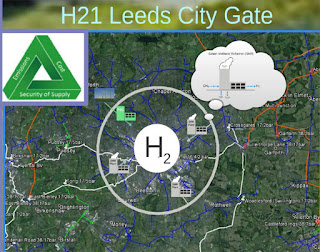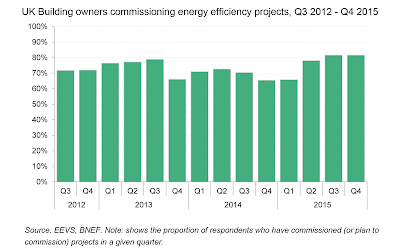The 'hydrogen city' plan involves building “steam methane reformer” plants
around the city to remove the carbon from methane in the national gas grid.
A £55 million pilot project to convert the
natural gas network in the city of Leeds to take hydrogen gas is being proposed
by the city's gas network provider. The 'hydrogen city' proposal is a leading
example of how some cities and energy supply companies are considering ways to
decarbonise heating and cooking in the future and become less dependent on
fossil fuels. Hydrogen produces only water and heat when burnt and, if made
using renewable fuels, is zero carbon.
Northern Gas Networks is responsible for
maintaining the gas grid infrastructure for 2.7 million homes in the north of
England. In this area, 85% of buildings use gas for heating space and water and
for cooking. The company sees the conversion of this network to take hydrogen
as affordable and possible on an incremental scale. It also sees potential for
using the hydrogen for a vehicle refuelling network and for heating, possibly
using micro-CHP, as part of the UK Government's 'Northern Powerhouse' project.
The plan to make Leeds a “hydrogen city”
would eventually cost about £2 billion and involve converting all domestic gas
boilers and cookers to run on hydrogen. Northern Gas Networks (NGN) has already
received £300,000 funding from energy regulator Ofgem
to develop the idea.
How much it will cost per year in billions of pounds Sterling in 2010 value to
convert and install natural gas and hydrogen residential heat technologies to
achieve an 80% reduction in CO2 emissions in 2050. Each point
represents the average annual investment over a 5-year period. Source
A
report
commissioned by NGN from KPMG consultants says that what's called the H21 Leeds
city Gate hydrogen project would position natural gas as more than a
'transitional fuel' on the UK's pathway to a low carbon economy. Desktop modelling
has shown that the current gas network in the UK and particular in Leeds is
large enough to convert hydrogen, and that because of its unique positioning,
Leeds should be the first city to convert.
“Households in Leeds could potentially cook
and heat their homes using pure hydrogen within 10 – 15 years,” a spokesman for
NGN said. The city would then become a centre of excellence for the hydrogen
economy, it is thought.
The project is now looking to secure £55
million to develop a roadmap to hydrogen consisting of evidence that would back
up the project's viability. The work is seen as split into 16 work packages,
covering over 50 projects. Part of this work will be to determine an overall
strategy for UK wide conversion over time.
Conversion would be a major infrastructural
transformation, and many hydrogen compatible appliances and burners would need
to be installed or converted, and a workforce trained to undertake the process.
Hydrogen and electricity would become the dominant heating fuels by 2050.
The gas grid
The UK benefits from an extensive natural
gas pipeline network that supplies 84% of homes. Worldwide, natural gas
supplies around 20% of residential heat, primarily in OECD countries.
Many of the old (local) low-pressure
distribution iron pipes are having to be replaced by polyethylene, and by 2030
this will be complete and they will be able to take hydrogen.
The (national) high-pressure gas
distribution pipes on the other hand are made of steel, which is unsuitable to
transport hydrogen, so a separate network for taking the hydrogen would have to
be constructed. This has happened before, when the network was converted from
town gas to natural gas over a 10-year period, so it is known to be feasible.
Using hydrogen in the network is just one
idea for its future, rather than decommission it completely, after the use of
natural gas has to be abandoned to meet the constraints of climate change.
Other possible uses are to carry bio-methane from the anaerobic digestion of
organic waste, and hydrogen injection.
A
2013
academic study on the future of the UK gas network determined that from a
cost point of view, hydrogen conversion was the cheapest option, and
recommended that the government adopted a long-term strategy to do so. It
concluded that renewable methane from anaerobic digestion could probably only
ever meet around ten per cent of total gas demand due to the limited
availability of the waste organic matter (food and agricultural waste).
The range of heat appliances in homes in 2050 necessary to achieve an 80%
reduction in CO2 emissions. Source
One of the drivers for the project is the
UK's 2008 Climate Change Act, which requires the government to reduce UK
greenhouse gas emissions in 2050 by 80% relative to 1990 levels.
A major stumbling block for this strategy
is the problem of carbon capture and storage. If the hydrogen is produced by
reforming methane, which is composed of carbon and hydrogen, the hydrogen would
be pumped into the gas grid, but the carbon would need to be stored underground
to prevent it entering the atmosphere. The likeliest place for storing it is
back underneath the North Sea, where the gas came from in the first place.
However, last year the government scrapped
a £1 billion carbon capture and storage pilot project that would test out this
idea, so no one yet knows whether this will work.
The use of hydrogen in the gas grid does
have the backing of the Institution of Gas Engineers and Managers, which has
already
said it will help in developing standards for the construction and testing
of hydrogen gas distribution systems and safety.
The role of hydrogen in decarbonising buildings
A
study published two years ago criticised governments for not considering
the role hydrogen could play in decarbonising buildings and heating. It
concluded that fuel cells can especially offer wider energy system benefits for
high-latitude countries because of their peak electricity demands in winter;
but the same could be true in low latitude countries which have a high electricity
demand for air conditioning.
The study argues that gas networks could
prove difficult to displace with alternatives, particularly because consumers
who have them like their gas boilers, which they perceive as safe, cheap,
effective and easy to control, so why not adapt the existing markets and
infrastructure for gaseous heating fuels and convert these to use hydrogen?
Both of the above academic studies are
co-authored by Paul E. Dodds of University College
London, an expert in energy economics. But the UK government also appears to be
backing the idea, building on a 2012 strategy paper on
The
Future of Heating: A strategic framework for low carbon heat in the UK.
This paper argues that although
constructing a high-pressure national grid for delivering hydrogen to
households could be very costly, as intercity pipes would need to resist
high-pressure hydrogen and corrosion, low-pressure local grids may be a more
viable solution. This will potentially enable them to be connected to other
local means of supplying the gas, for example by the electrolytic splitting of
water using renewable electricity when more of it is being generated than is
required at the time, such as by wind power at night.
A follow-up 2014
White
Paper from the UK Hydrogen and Fuel Cell (H2FC) SUPERGEN Hub examined the
roles and potential benefits of hydrogen and fuel cell technologies for heat
provision in future low-carbon energy systems. It agreed with the idea and
proposed that in the shorter term small amounts of hydrogen be injected into
the gas networks to reduce the emissions intensity of grid gas.
It also criticised government policies on
renewable heat for marginalising hydrogen and fuel cells.
This approach, together with the use of
fuel cell micro-CHP, would reduce the need to depend on heat pumps as the main
solution for decarbonising heating. Heat pumps have recently been criticised
because they either require a lot of space or, in the case of air course heat
pumps, are too noisy.
The options for micro-CHP
Micro-CHP (combined heat and power) is a
boiler that not only heats a building but also generates electricity. It's
around the size of a small fridge or washing machine.
Like their big brother, conventional CHP, it uses
the gas more efficiently, making the boiler 90% efficient.
The current crop of models are based on the
Stirling engine, Organic Rankine Cycle (ORC) or
internal combustion engine.
The first
two have high thermal efficiency and output but low electrical efficiency
(10%), and this is a sticking point.
The cumulative
number of fuel cell micro-CHP systems deployed in three major regions, showing
historic growth (solid lines) and near-term projections (dotted lines). Source.
A
2011
trial by the UK’s Carbon Trust concluded that micro-CHP can cut electricity
bills and overall CO
2 emissions by 15–20% when they’re the lead
boiler in larger contexts like care homes, district schemes, apartment blocks
and leisure centres.
The best application
for them therefore is a medium-to-large, moderately well-insulated building, perhaps
with solid walls, solid floors and no loft space, that is hard to insulate well
and has a relatively large heat demand; or a cluster of buildings.
Micro-CHP offers more limited benefits for
smaller and newer dwellings, however, because they are more energy-efficient or
have too little requirement for heat.
The key to success in micro-CHP is matching
the thermal output to the building’s pattern of use, so that they operate not
intermittently but for many hours at a time, making the value of electricity
generated pay for the marginal investment as quickly as possible. It therefore
works best with a buffer storage tank to save the surplus heat for later. Grid
connection for electricity export is crucial to micro-CHP’s widespread
acceptance.
On average, half of all electricity generated
by a typical 1kWe micro-CHP device is exported to the grid, as it’s not needed
at the time. Reliability is also a key issue; service agreements will be
essential.
Superinsulated
homes will have to wait until the next generation of machines,
based on fuel cells. These generally come in two types – proton exchange
membrane fuel cells (PEMFCs) and solid oxide fuel cells (SOFCs). They have a
heat to power ratio that is approximately equal, so for example they could
produce 5kW of heat and 5kW of electricity.
CO2 savings from fuel cells are therefore
country- and site-specific, depending on the carbon intensity of grid
electricity and on the heating system that is displaced.
At five times the installation cost
of residential gas boilers (around £12,000 for 1 kW residential systems,
but costs are falling 10–15% per year), they're not cheap but are beginning
to compete with other low-carbon heating technologies and their running
costs are lower, even without public policy support.
Hydrogen in the home
The range of heat appliances in homes in 2050 necessary to achieve an 80%
reduction in CO2 emissions, with and without hydrogen conversion. Source
By contrast, could we live with hydrogen?
The physical properties of hydrogen differ from natural gas, so switching to
hydrogen would require changes not only to the gas network but to heating and
cooking appliances.
Gas appliances designed for natural gas
cannot generally be used directly with hydrogen, mainly because the combustion
velocity or flame speed is higher for hydrogen than for natural gas. Conversion
would mean replacing the burner heads. Hydrogen also spontaneously ignites much
more quickly than natural gas, which will necessitate modifications to
spark-ignition gas engines and gas turbines to avoid flashback and knocking.
Hydrogen has a lower calorific value than
natural gas per unit of volume, so a greater volume of gas must be burned for
the same heat level. But this is made up for by the fact that the gas flows
quicker under the same pressure due to its lighter molecules. Hydrogen is also
invisible and odourless, so would need odorants to be added to it to enable
detection for safety reasons.
However, because hydrogen can be burnt
directly in a combi-boiler it requires no additional
space in the home. Hydrogen boilers are also much cheaper than heat pumps. They
could therefore provide zero-carbon heat without much disruption to living
patterns, while being affordable.
Hydrogen may also be used for district heating.
Boilers designed specifically for hydrogen are under development.
Gas heat pumps may also be converted to
hydrogen. These are already commercially available in some countries for
household or commercial use, and have much higher efficiencies than gas
boilers.
The road to a hydrogen city is clearly a
long one that is not without difficulties. However, Northern Gas Networks is
one gas network operator that is not going to give up the value of its assets
easily and is determined to explore the options.
Leeds, a pioneer city of the first
industrial revolution, could yet become a pioneer of the post-carbon
revolution.
David Thorpe is the author of:






















